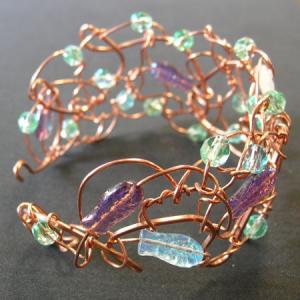What, exactly, are “traditional metalsmithing techniques”?
I’ve tried to figure it out because I see this phrase all over the place. So far, the only thing I’ve managed to determine is that it’s a blanket term for an assumed, but ill-defined, set of construction methods a skilled metalworker must know how to use.
A couple of months ago I opened up an Artfire Shop. Like “street teams” on Etsy, Artfire encourages craftspeople to band together and form “guilds” according to their specialties. I applied to join a Metalsmiths Guild, and was rejected. The reason given: “All members must have metalsmithed pieces listed live in their Pro Studio, and those metalsmithed pieces must make the majority of the items listed in their Studio, because our focus here is Metalsmithing. Your studio is basically filled with beautiful wire wrapped pieces at this time.”
When I went to look at the Guild Master’s shop, I discovered that about half of her available work was made of wire, much of it cold-worked. The difference? She was hammering it, as well as wrapping it.
There were several pieces of wirework on the Guild’s gallery page, and when I pointed this out to her, I got an indignant reply: “…there is not a single wire wrapped piece displayed in the [Guild] photo gallery. Not one piece. (except for one of my copper Hearts which has a few soldered components, as well as a wire ”stitching” detail around the heart, but that is not what we”d call ”wire wrapping” per say)”
She went on: “So, I”m really not sure where you saw this when you say “I note that several of your members have wireworked pieces included in the guild gallery.” – you were not looking at the [Guild] gallery. I can guarantee you that.”
I didn’t say wire wrapped, I said wireworked, and there were definitely several pieces in the Guild’s gallery. Once again, I was being slapped with dismissive terminology.
She sounded positively offended at the insinuation that any cold-joined wire jewellery might be included. “For the [Guild], we ask that our members focus on pieces geared towards ”traditional” metalsmithing techniques… ”
In the first essay of this series, I established that there are three major forms of metalworking: sheet, cast and wire. As the exchange with my ArtFire correspondent shows, there are divergent opinions about what construction methods are needed in order to actually call oneself a metalsmith. So, let’s start with a definition:
Met-al-smith, noun
∙ an artist or craftsman who works with metal, esp. in making sculptures, jewelry, etc. [1. YourDictionary.com/metalsmith]
∙ a person skilled in metalworking [2. Merriam Webster]
Let’s also clarify what “traditional” means:
Traditional, adjective
1. based on customs usually handed down from a previous generation <a traditional Passover meal at his grandparents’ house>
2. tending to favor established ideas, conditions, or institutions <a family that is very traditional when it comes to institutions like marriage>[3. Merriam Webster]
Wire jewellery – and in particular cold-joined wire jewellery – has a very long history, as evidenced by pieces in the collection of the British Museum, here, here, here, here, here and here and in the Victoria & Albert Museum here, here, here and here. In fact, this brooch dating from the Middle Bronze Age is among the oldest known pieces of classical cold-working.
Doing a search online for “wire wrapping” brings up all kinds of references to electrical equipment. I was surprised to find only one definition of “wire wrap jewellery”:
Wire wrap jewellery is a type of design and method of hand jewellery fabrication. [4. WordIQ.com] (emphasis mine)
Hand fabricated jewellery is built from constructed and assembled pieces, which have been soldered or cold-joined. It can use sheet, wire, found objects, you name it. Hand fabricated wire jewellery can incorporate a wide variety of different cold-joining methods such as weaving, coiling, seizing, stitching and lashing.
The single element which determines whether a piece of cold-joined wire jewellery is called “wire wrapping” is the presence of binding.
Tim McCreight lists wire “wrapping” second after “tabs” in Chapter 5 “Joining” of The Complete Metalsmith. He writes: “It’s hard to get much simpler than binding elements together with wire. Countless examples can be found in farm tools, kitchen utensils and ethnic jewelry from around the world.” [4. McCreight, Tim. The Complete Metalsmith, (Portland: Brynmorgan Press Inc., 2004), ISBN 1-929565-05-4, pg. 102] (emphasis mine)
In fact, he refers to “wire wrapping” as “The Original Cold Connection”. [5. McCreight, Tim. The Complete Metalsmith, (Portland: Brynmorgan Press Inc., 2004), ISBN 1-929565-05-4, pg. 221]
In other words, it’s a traditional metalsmithing technique.
<Previous Please Don’t Call Me a “Wirewrapper”





